Alcaraz leads seeds Exodus; Fonseca hitting highs
50/50 — wide serves — short chips — high forehands — backhand grips
Four of the top eight seeds crashed out in round two of the Miami Masters this weekend. The fallen included world #3 Carlos Alcaraz (lost to Goffin), recent Indian Wells champion #7 Jack Draper (lost to Mensik), 2023 champion #8 Daniil Medvedev (lost to Munar), and #9 Andrey Rublev (lost to Bergs).
In addition to these upsets, local boy Ben Shelton fell to 20-year-old Coleman Wong; Ugo Humbert was taken to the sheds by Joao Fonseca; and Holger Rune was served out in a third set tiebreaker by servebot Reilly Opelka, to make that seven of the top-20 gone from the event after round two.
“The beauty of my game is I got a 50/50 with anybody. The bad part of my game is that I got a 50/50 with anybody.”
— Reilly Opelka for Tennis TV
Alcaraz’s loss to Goffin was the biggest upset. The Belgian served and played a brand of tennis that was reminiscent of Djokovic’s win over the Spaniard in the quarterfinal of the Australian Open two months prior. That is, excellent wide serving to the Alcaraz forehand on the deuce wing, as well as assuming an aggressive court position on returns and more generally in the rally.
Here was an early example of how well Goffin can handle and redirect pace on his backhand wing:

It also contained that defensive slice from Carlos, with Goffin managing to close on it and hit it from above the net on this occasion.
Later in the match — and on a big point — the Spaniard managed a better slice, but would be ruing missing the easier forehand in this two-shot pass:
Given Goffin’s exceptional baseline timing and ability to redirect pace, I was surprised to see Alcaraz not use his slice backhand more often, to both disrupt Goffin’s rhythm, and buy Carlos more time, like he did on this occasion late in the match:

Again, this was a tactic that I thought Alcaraz should have used more often against an injured and aggressive Djokovic in Australia. An excerpt:
The Serb excels at linear hitting around the waist, so if you get it low and force him to sacrifice his racquet speed to vertical lift/spin generation, that slows his ball down, and it buys Alcaraz time to load up on his shots a little more with his body.
But besides the rally, the serve-return dynamic was the most interesting to me. Alcaraz averaged 201km/h on his first serve and hit eight aces, whereas Goffin’s was only 177 km/h for just three aces, but it was the Belgian who was more effective, winning 69% to Alcaraz’ 64%.
Goffin hit the majority of his first-serves into the forehand corner of Alcaraz on both sides, and he was wildly effective. Look at all the green, particularly on the deuce court (the large number of sliders out wide also partly explain the slower first-serve speed of Goffin):
By comparison, Alcaraz was far more varied in his first-serve direction, mixing in the jamming body serve (unsuccessfully) against an aggressive Goffin. It looks like he should have stuck to the corners:
Perhaps most surprising about this result is that we’ve seen this tactic before from Alcaraz opponents (covered here with Djokovic in their most recent Australian Open quarterfinal clash, and Medvedev at Wimbledon 2024). At Wimbledon Medvedev totally dominated the Alcaraz deuce forehand return for a period of their semifinal clash:
But as I covered in Alcaraz’s 2024 Wimbledon victory over Djokovic, in that particular match Alcaraz learned quickly from his semifinal, and chipped his forehand return a lot in the final. An excerpt:
Of the 17 returns the Spaniard got a racquet on, 13 were directed to his forehand. This was the strategy that Medvedev had employed in the semifinal to great effect, and the one I felt Djokovic would find success with, but on Sunday, Alcaraz — ever the shapeshifter — morphed into a block aficionado. Of the 13 forehand returns Alcaraz hit, 10 were blocked. He won 7/10 of these points, often baiting Djokovic into the net and then passing or forcing a volley error.
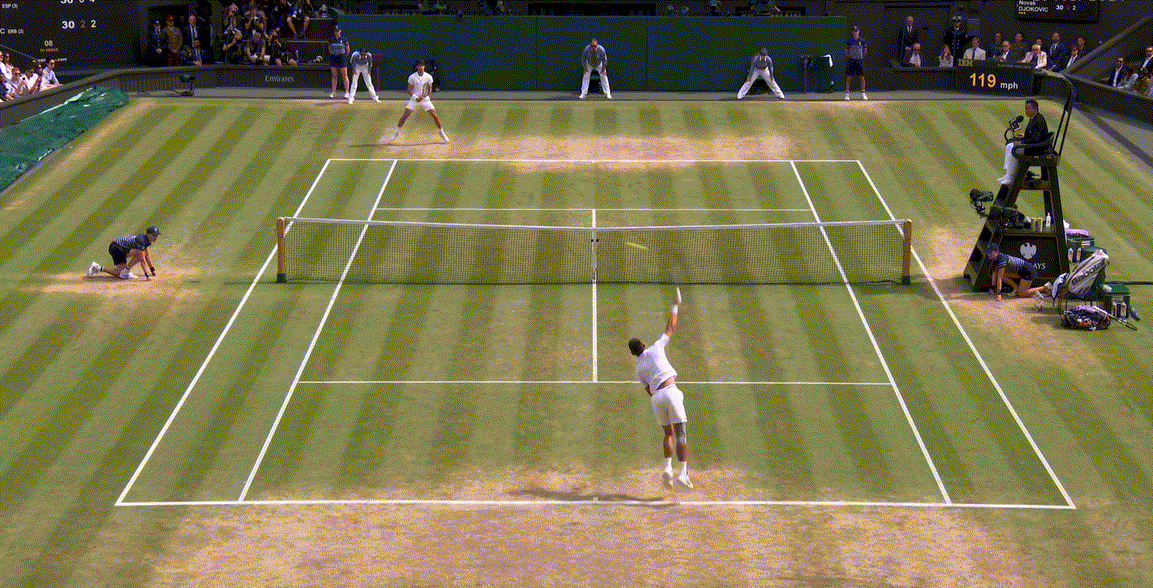
I also think Alcaraz likes a target on his running forehand, as opposed to having someone stay on the baseline.

I only recall Alcaraz chipping his deuce forehand return twice (voluntarily — when stretched defensively he is forced to), midway through the second set from memory, and I couldn’t help but wonder if he should have both tried it sooner, and persisted for longer, considering that Goffin isn’t a particularly big hitter. Plus, the Belgian also hits relatively flat (especially off his backhand), rendering a chip return a pretty effective way to force Goffin to generate his own pace from low and short (that is, closer to the net) areas and move forward (not his M.O.) rather than simply trade and redirect linear power from the baseline (something far more in the Belgian’s wheelhouse).

There’s a certain match-up where I feel short and low returns (intentional or otherwise) can be effective. Explosive movers with good hands — Alcaraz, Dimitrov, Federer — can use it against players who don’t excel at producing their own racquet and ball speed (Zverev, Medvedev, de Minaur) and who may not excel at the net (Rublev, Fritz, Medvedev).
From last year’s Indian Wells final piece:
Carlos opted out of the linear battle and started to play the ball above the shoulders and below the waist of Daniil. If there is a worthy criticism of Medvedev’s forehand, it is his lack of ability to generate power and spin outside his hip strike zone.
This lack of pace and spin injection means a skilled defender like Alcaraz can actually bait Medvedev into the net in a favourable manner. Federer used to do this to Roddick’s backhand. Chip low and short:
There’s gotta be ten other examples in this one match from the Federer/Roddick highlights alone.
Here’s one from Rotterdam recently:
I even thought Dimitrov should have done it against Sinner in last year’s Miami final more, considering how out-gunned he was in the baseline-to-baseline exchanges. Forcing even someone of Sinner’s calibre to approach off a low slice means a likely slower and higher bouncing ball (by virtue of the opponent having to dedicate a lot of racquet speed to lifting the ball with spin to get it over the net and down into the court), or approaching off a slice themselves. It also means as an explosive mover and talented shot-maker, you get a target to aim for on your second shot in the rally, with an opponent who may not feel entirely comfortable on the net. Here’s an example:
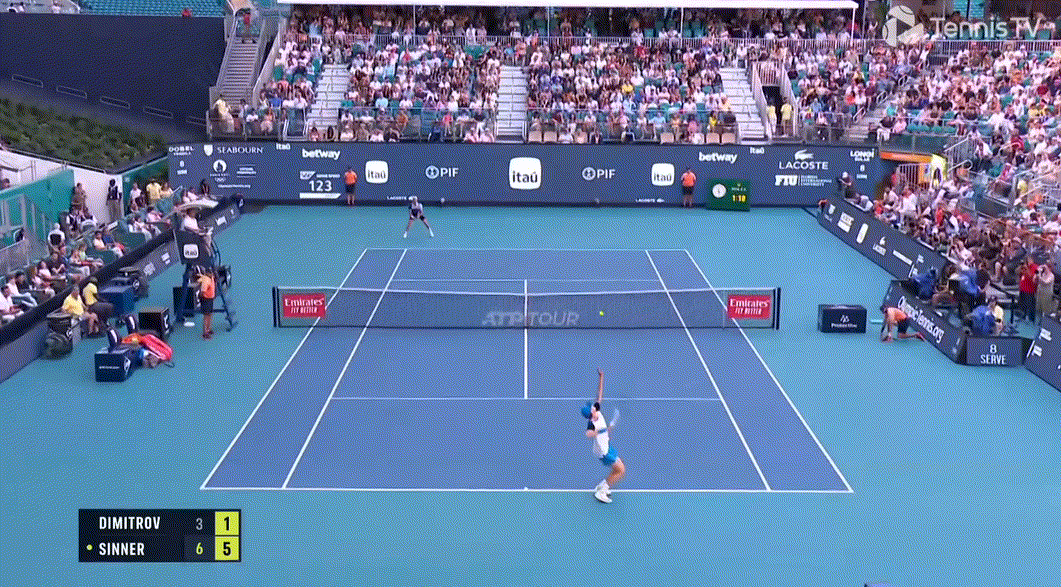
I think people often think of long rallies when you mention defence. But blocking returns is a great way to create a defensive situation with your anaerobic fuel tanks fully stocked. Given Alcaraz’s speed and court craft, I think he could employ it more often, especially now that the rest of the tour will be looking at this match and seeing another data point for the “Alcaraz forehand weakness” narrative.
At the other end of the returning spectrum, I was also surprised to see that not once by my viewing did Alcaraz drop back on second serves to look for a bigger cut or simple change of rhythm.
Both Goffin and Alcaraz won 55% of second serve points, and it was interesting to me that Alcaraz never ventured back to create a different ball, a change in rhythm, or simply to give a different look to perhaps create a seed of doubt in Goffin’s tactic and serving rhythm (he serve impeccably well in the third set).
It was at the 2022 Miami Masters — Alcaraz’s first masters title — that was the genesis of this graph that I display so often:
This North-South movement and deep-return shot-making has been a feature of his game since he first came on tour, but against Goffin, it all seemed so linear and baseline-hugging.
It was only 12 months ago that I wrote this of Alcaraz, having come back from a 6-1 first set drubbing against Sinner in their Indian Wells clash (emphasis added):
There’s always a certain tempo, place and height that players are comfortable playing in, but Alcaraz is the tennis equivalent of a jazz player, able to seamlessly change his spins, depths, and positions on the court in a bid to change the rhythm of a match. The more he leans into that feature, the more he can take his opponent’s out of theirs.
Against Sinner, Alcaraz created time in two ways: (1) he stood deeper on return; and (2) he used more height on his forehand, and added more slice on the backhand. He also stole time, by closing the net and taking the ball earlier after a good ball.
While the rest of the tour seems to be leaning into a linear, powerful, and unimodal baseline style, Alcaraz should be venturing further into what makes him unique, namely, his variation.
I don’t just mean the drop shot.
I mean the higher forehand returns from deep:
And the backhand returns from deep, too:
I mean the crush-and-rush second serves:
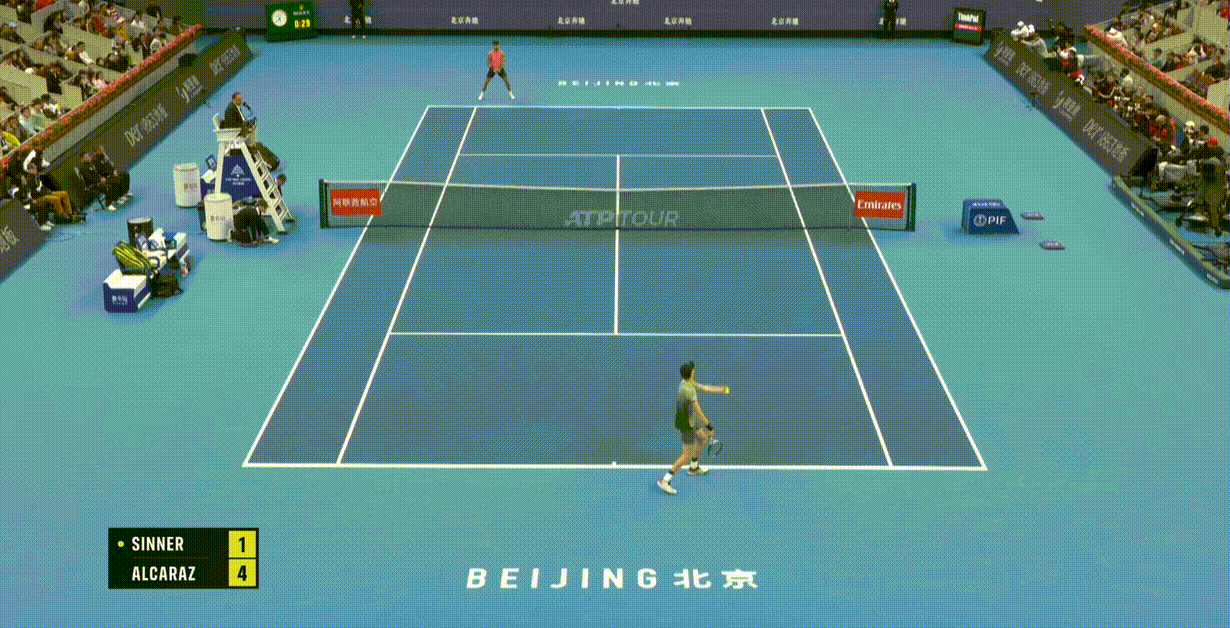
I mean the slice backhands and sharply angled, shorter forehands:
All that variation is going to waste when he’s caught in linear battles with guys like Djokovic, Sinner, and Goffin.
It’s not from a lack of trying, perhaps. Alcaraz admitted to feeling off after the match:
"I didn't play well, and I didn't feel good physically either. In these kinds of matches, when you don't feel that confidence either in terms of tennis skills or physically, everything becomes much harder."
Alcaraz now turns his focus to the clay season; a surface that naturally helps the Spaniard lean into his variation and court craft.
Fonseca forehands (and backhands)
Fonseca took down Ugo Humbert in the second round on Saturday, becoming the youngest player since Alcaraz to reach the third round of a Masters, and the youngest since Juan Martin del Potro to reach the third round of the Miami Masters.
That’s good forehand company.
And speaking of forehands, one of the little quirks of the Brazilian’s cannon is that he often opts to take it from way above his shoulders. I first noticed it in Buenos Aires:
And he does it time and again. Contact way above the head:
It’s almost like he opts to take the ball at the peak of the bounce, where the ball is just sitting there, no matter how high it might get above the shoulder.
Another little quirk of his game is how extreme his top hand is on the backhand. Most players are some variation of eastern with their left hand, but Fonseca is all semi-western:
Compare Fils’ top-hand thumb knuckle and subsequent extended wrist position with Fonseca’s neutral wrist:
More on that in a later article.
Grips aside, Fonseca left an impression on Humbert:
Fonseca takes on de Minaur in round three in what should be a great match.
Might be back later in the event with other things that catch my eye. See you in the comments. HC.




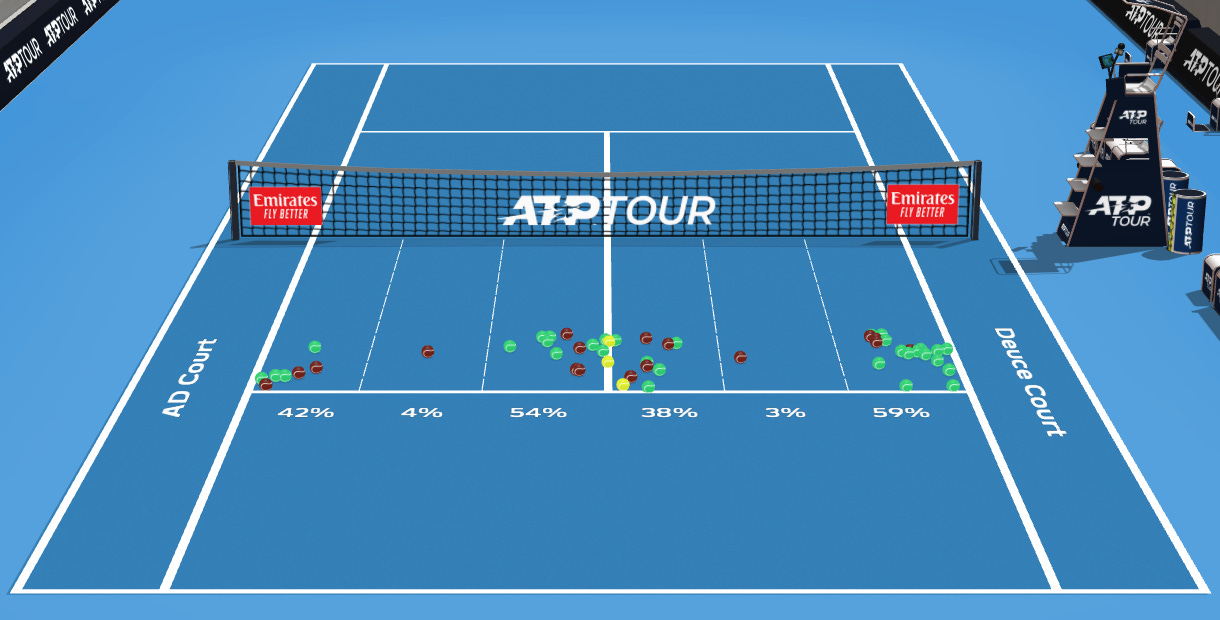
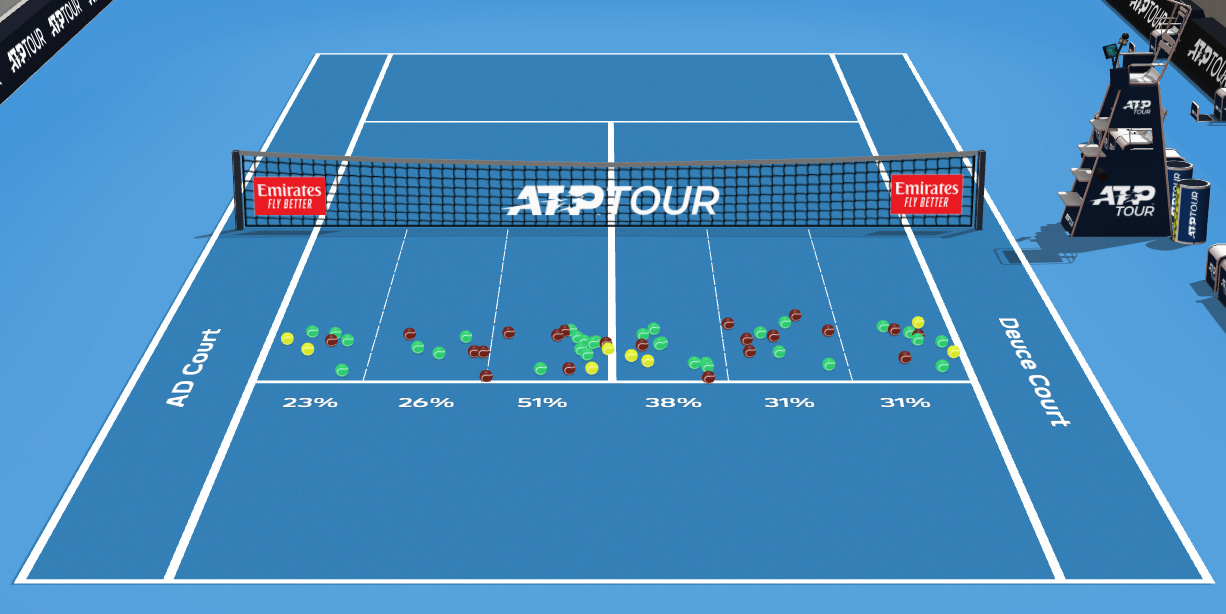
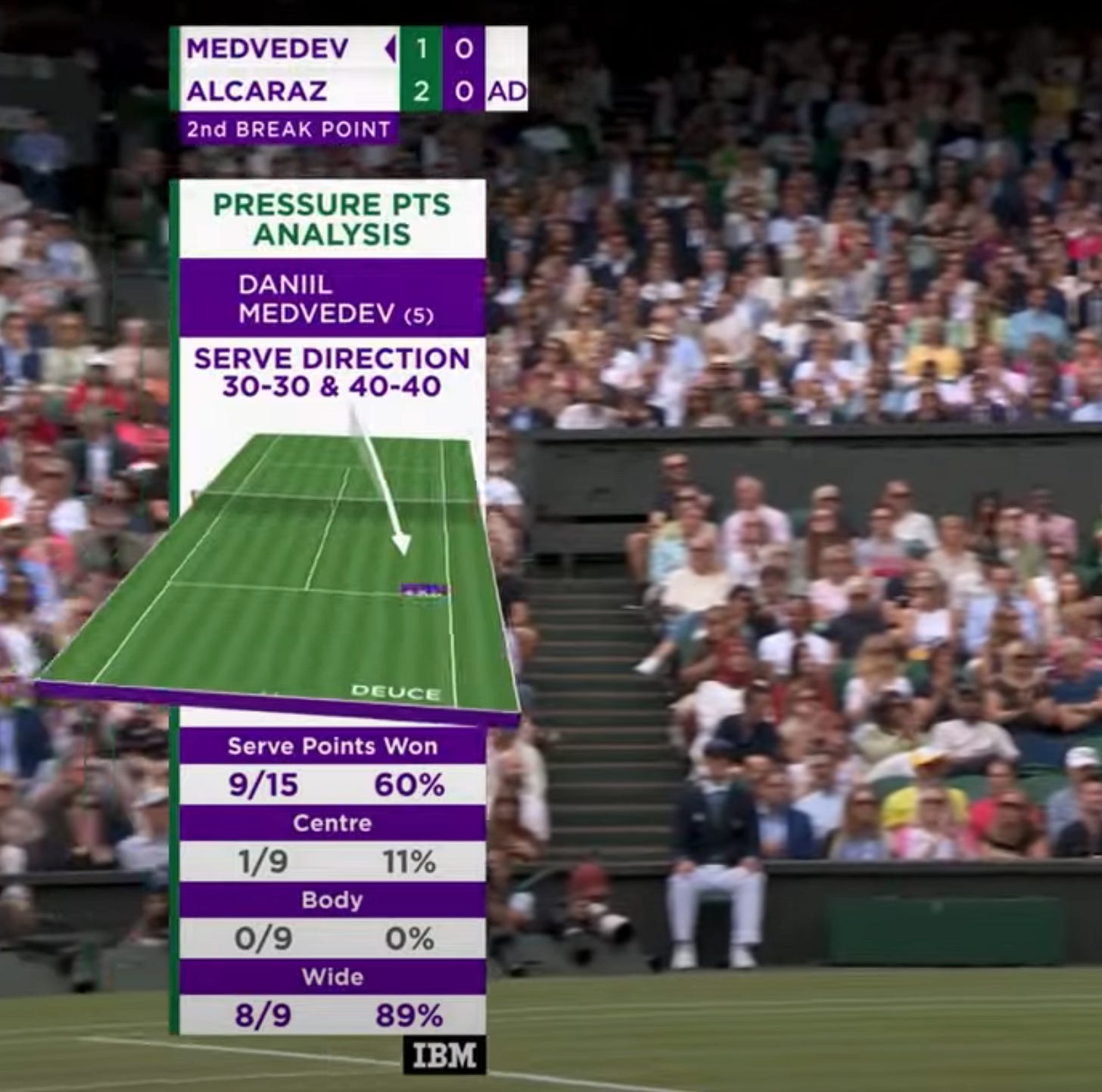














Fascinating reading as always ! I have couple of questions regarding some tactical insights you discussed ! i will try to be quick ( doubt it ) but so many stuff going through my head rn lmao:
1- firstly in that alcaraz goffin match, you mentionned how of a reminiscent of that djokovic alcaraz AO clash that was with goffin opting for the same tactic ! what really suprise me is how alcaraz seemed to have NOT learn at all from that previous match ? You litteraly spotted back in january that alcaraz didnt slice enough, didnt change return postions enough, didnt chip the forehand return enough ect ect and he did the same mistakes all over again ! What I really understand from your analysis is that alcaraz main problem rn its not that much from a technical stand point but more from a TACTICAL perspective ! obviously we discused the backhand and the serve as improvable but what seem to cost the majority of alcaraz matches is his lack of awareness and adaptibilty during adversity ! It hasnt always been the case imo but here its very obvious ! Vs goffin i felt he didnt play that bad...he missed, like you highlighted in some videos, some "easy" put away forehands that he usualy makes but seemed to be in shape physically ( with some unreal points ). Yeah tacticaly wasnt clever btw no idea why ferrero didnt say a word abt that ???
2- You brillantly wrote abt the return dynamic and dynamic players like fed alcaraz dimi ...slicing that return in play against "players who don’t excel at producing their own racquet and ball speed (Zverev, Medvedev, de Minaur) and who may not excel at the net (Rublev, Fritz, Medvedev)." My question is multiple :)
- How can those guys ( servers that will face this situation of playing off a low slice) counter attack this play to make the rally back on their own term ? change the serve speed, body serve ? or something else i guess.... cause for exemple this is so effective like u said against novak at wimbledon ect but how could novak ( who doesnt like dead balls and net approches) flip that around and make carlos unconfortable ?
- Is it a wrong tactic if it is used the other way around against Fed, carlos...like if a guy like zverev decided to drag carlos to the net off dead balls, you feel its not the best stuff to do considering ,carlos or grigor whatever, have unreal net games ?
I always ask myself abt that cause love to understand abt tactic one guy can put in play but also understand how the opponent can adjust and make it tough for him !
3- Now abt the Fonseca deminaure match coming up ! wanted to know quicly ur opinion on it ! Should fonseca use that alcaraz tactical theme he performed in rotterdam ( short slices to force deminaure come to the net off difficult approach shots he often struggle with his technique) or should he be aggressive from the first ball ! fonseca obviously doesnt have the court coverage and stealing percentage of carlos which why if I answer to that question myself i would say stick to aggressive play but who knows i might be wrong...
and lastly ( Finally ) Fils Tiafoe tactical approach ? obvisously my immediate thought is fils wanting to keep frances in that forehand crosscourt exchange but regarding serve and return patter what should he do ?
Thanks hugh if you ever reach to that point :)) almost wrote a whole article myself
How about that court change by the so called Schedulers. A new level of incompetence. They announced a court change from Grandstand late in the Draper match. All the Brazilian fans, who were already there waiting to see Fonseca, were very unhappy, justifiably so. It caused about a 10 minute delay in the Draper match as the fans all filed out, while booing. It is hard to believe how little they know about tennis.